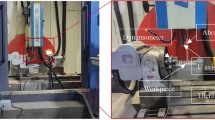Abstract
Adhesion wear on abrasive belt sometimes occurs as an abnormal abrasion way because of an improper selecting on working conditions during the belt finishing. In this paper, the forming process of the adhesion wear and its effects on the finished surface is investigated through a series of experiments. The results reveal that the applied pressure and the belt feed rate are supposed to be the two sensitive variables for forming the adhesion wear. A certain amount of accumulated chips is a trigger to cause adhesion wear initially, and then, the sufficient heat accumulation becomes the main factor for the following adhesion wear. Thus, shortening the finishing duration, decreasing applied pressure, rotating speed and introducing cooling/lubrication system are recommended to avoid adhesion wear. The belt finishing process with adhesion presents a potential to further decrease surface roughness by 30% maximum, improve bearing characteristics and obtain equivalently high compressive residual stresses; however, this merit has to go with the sacrifice of belt’s cutting ability.















Similar content being viewed by others
References
Ren X, Cabaravdic M, Zhang X, Kuhlenkötter B (2007) A local process model for simulation of robotic belt grinding. Int J Mach Tools Manuf 47:962–970
Wang Y, Huang Y, Chen Y, Yang Z (2016) Model of an abrasive belt grinding surface removal contour and its application. Int J Adv Manuf Technol 82:2113–2122
He Z, Li J, Liu Y, Nie M, Fan W (2017) Investigating the effects of contact pressure on rail material abrasive belt grinding performance. Int J Adv Manuf Technol 93:779–786
Khellouki A, Rech J, Zahouani H (2007) The effect of abrasive grain’s wear and contact conditions on surface texture in belt finishing. Wear 263:81–87
Serpin K, Mezghani S, Mansori ME (2015) Wear study of structured coated belts in advanced abrasive belt finishing. Surf Coat Technol 284:365–376
Rech J, Kermouche G, Grzesik W, Garcia-Rosales C, Khellouki A, Garcia-Navas V (2008) Characterization and modelling of the residual stresses induced by belt finishing on a AISI52100 hardened steel. J Mater Process Technol 208:187–195
Khellouki A, Rech J, Zahouani H (2009) The effect of lubrication conditions on belt finishing. Int J Mach Tools Manuf 50:917–921
Mansori ME, Sura E, Ghidossi P, Deblaise S, Dal T, Khanfir H (2007) Toward physical description of form and finish performance in dry belt finishing process by a tribo-energetic approach. J Mater Process Technol 182:498–511
Wang W, Salvatore F, Rech J, Li J (2018) Comprehensive investigation on mechanisms of dry belt grinding on AISI52100 hardened steel. Tribol Int 121:310–320
Wang W, Salvatore F, Rech J, Li J (2018) Investigating effects of adhesion wear on cutting efficiency and energy cost in dry belt finishing. Int J Adv Manuf Technol 95(5–8):2119–2123
Autech (2017) Product introduction of HGS maintenance module. https://autech.ch/en/at-3314-en/. Accessed 26 May 2018
Khellouki A, Rech J, Zahouani H (2007) Influence of the belt-finishing process on the surface texture obtained by hard turning. Proc Inst Mech Eng Part B J Eng Manuf 221:1129–1137
Sura E, Mansori ME, Ghidossi P, Deblaise S, Negro TD, Khanfir H (2007) An energy analysis of belt polishing process and its applications to time cycle and tracking effects. Mach Sci Technol 11:217–234
Grzesik W, Rech J, Wanat T (2007) Surface finish on hardened bearing steel parts produced by superhard and abrasive tools. Int J Adv Manuf Technol 47:255–262
Rech J, Kermouche G, Claudin C, Khellouki A, Grzesik W (2008) Modelling of the residual stresses induced by belt finishing on a AISI52100 hardened steel. Int J Mater Form 1:567–570
Acknowledgements
The authors would like to thanks Ir. Mehmet Cici for the experiment operation.
Funding
This work was funded by China Scholarship Council (Grant Number 201607090033).
Author information
Authors and Affiliations
Corresponding author
Rights and permissions
About this article
Cite this article
Wang, W., Salvatore, F., Rech, J. et al. Investigating adhesion wear on belt and its effects on dry belt finishing. J Braz. Soc. Mech. Sci. Eng. 40, 570 (2018). https://doi.org/10.1007/s40430-018-1496-7
Received:
Accepted:
Published:
DOI: https://doi.org/10.1007/s40430-018-1496-7




